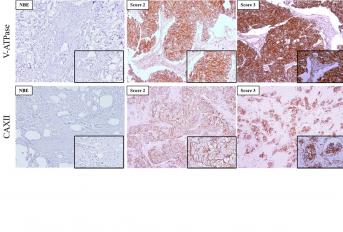Associação Portuguesa de Investigação em Cancro
A disrupção do controlo do pH das células de cancro da mama diminui a agressividade e potencia a resposta à quimioterapia
A disrupção do controlo do pH das células de cancro da mama diminui a agressividade e potencia a resposta à quimioterapia

O gradiente reverso de pH é uma característica comum das células malignas, em que o pH intracelular é mais alcalino e o extracelular mais acídico, fator que está associado a uma maior agressividade. As células malignas conseguem manter este gradiente de pH à custa da atividade aumentada de várias proteínas reguladoras de pH (proteínas membranares), como sejam as ATPases, anidrases carbónicas (CAs), transportadores de monocarboxilatos (MCTs) e os trocadores sódio–protão (NHEs). Neste trabalho, os investigadores avaliaram a expressão destas proteínas em amostras humanas de cancro da mama e exploraram a sua inibição como estratégia terapêutica. A expressão dos reguladores de pH encontra-se aumentada na membrana plasmática das células malignas, comparando com o tecido não tumoral, e a sua expressão varia com o subtipo tumoral. O uso de inibidores dos reguladores de pH em células de cancro da mama diminuiu a agressividade destas células e sensibilizou as mesmas para o efeito da doxorrubicina (quimioterapia), o que significa que serão necessárias doses menores de quimioterapia, diminuindo as reações adversas. Os resultados apoiam o uso de inibidores dos reguladores de pH com estratégia terapêutica para o cancro da mama, tanto como tratamento individual como em associação com a quimioterapia.
Autores e Afiliações:
Diana Tavares-Valente1,2,3, Bárbara Sousa4,5, Fernando Schmitt4,6, Fátima Baltazar1,2 and Odília Queirós3
1 Life and Health Sciences Research Institute (ICVS), School of Medicine, University of Minho, 4710-057 Braga, Portugal;
2 PT Government Associate Laboratory, ICVS/3B’s—Life and Health Sciences Research Institute/Biomaterials, Biodegradables and Biomimetics, 4710-057 Braga/Guimarães, Portugal
3 Department of Sciences, IINFACTS—Institute of Research and Advanced Training in Health Sciences and Technologies, University Institute of Health Sciences (IUCS), CESPU, CRL, 4585-116 Gandra, Portugal
4 IPATIMUP—Institute of Molecular Pathology and Immunology of the University of Porto, University of Porto, 4200-135 Porto, Portugal;
5 i3S—Institute for Research & Innovation in Health, University of Porto, 4200-135 Porto, Portugal
6 FMUP—Faculty of Medicine of the University of Porto, University of Porto, 4200-319 Porto, Portugal
Abstract:
The reverse pH gradient is a major feature associated with cancer cell reprogrammed metabolism. This phenotype is supported by increased activity of pH regulators like ATPases, carbonic anhydrases (CAs), monocarboxylate transporters (MCTs) and sodium–proton exchangers (NHEs) that induce an acidic tumor microenvironment, responsible for the cancer acid-resistant phenotype. In this work, we analyzed the expression of these pH regulators and explored their inhibition in breast cancer cells as a strategy to enhance the sensitivity to chemotherapy. Expression of the different pH regulators was evaluated by immunofluorescence and Western blot in two breast cancer cell lines (MDA-MB-231 and MCF-7) and by immunohistochemistry in human breast cancer tissues. Cell viability, migration and invasion were evaluated upon exposure to the pH regulator inhibitors (PRIs) concanamycin-A, cariporide, acetazolamide and cyano-4 hydroxycinnamate. Additionally, PRIs were combined with doxorubicin to analyze the effect of cell pH dynamic disruption on doxorubicin sensitivity. Both cancer cell lines expressed all pH regulators, except for MCT1 and CAXII, only expressed in MCF-7 cells. There was higher plasma membrane expression of the pH regulators in human breast cancer tissues than in normal breast epithelium. Additionally, pH regulator expression was significantly associated with different molecular subtypes of breast cancer. pH regulator inhibition decreased cancer cell aggressiveness, with a higher effect in MDA-MB-231. A synergistic inhibitory effect was observed when PRIs were combined with doxorubicin in the breast cancer cell line viability. Our results support proton dynamic disruption as a breast cancer antitumor strategy and the use of PRIs to boost the activity of conventional therapy.
Revista: Pharmaceutics
Link: https://www.ncbi.nlm.nih.gov/pmc/articles/PMC7916175/pdf/pharmaceutics-13-00242.pdf




